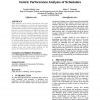493 search results - page 73 / 99 » Representing preferences using intervals |
TASLP
2010
13 years 2 months ago
2010
To solve the knowledge bottleneck problem, active learning has been widely used for its ability to automatically select the most informative unlabeled examples for human annotation...
DATAMINE
2002
13 years 7 months ago
2002
Discrete values have important roles in data mining and knowledge discovery. They are about intervals of numbers which are more concise to represent and specify, easier to use and ...
CVPR
2010
IEEE
14 years 3 months ago
2010
IEEE
Time-varying spatial patterns are common, but few computational tools exist for discovering and tracking multiple, sometimes overlapping, spatial structures of targets. We propose...
IROS
2008
IEEE
14 years 2 months ago
2008
IEEE
— This paper presents an integrative approach to solve the coupled problem of reaching and grasping an object in a cluttered environment with a humanoid robot. While finding an ...
HPDC
2007
IEEE
14 years 2 months ago
2007
IEEE
Utility functions can be used to represent the value users attach to job completion as a function of turnaround time. Most previous scheduling research used simple synthetic repre...

